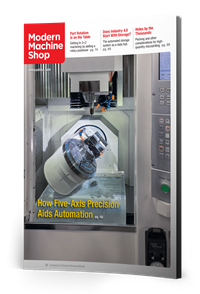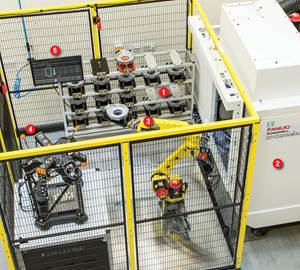Video: 5 Questions about Automation in Manufacturing
Productive uses of automation often involve people and technology working in parallel to complement one another.
Share






Video Transcription
What is Automation?
Automation in manufacturing is a means to keep the process meaning from step to step from cycle to cycle without a human being having to intervene. We hear automation and we think…robots? Manufacturers are using significantly more robots, but five axis machining is also automation. Also, bar feeds, indexers, software tools that streamline planning and programming are animation as well.
Is Automation replacing people?
Rarely would an employer say, “I can’t find someone to fill this job, therefore I’m going to automate”. One is not a replacement for the other. Manufacturers use automation to bridge gaps in which employees don’t produce. An example is a line or a cell that keeps on running into the night after the employees have gone home. Another is a highly repetitive automated process that keeps on running so that the employees can turn away from it, walk away from it here and there to tend to other tasks. The employer that learns to succeed with automation this way, using it to leverage what the employees can do, often is able to expand production without expanding staff. But, at the same time, many employers have added staff after automating because the multiplying effect of the automation makes each incremental employee that much valuable.
Is unattended production the only reason to use automation?
Beyond unattended production another reason to use automation is repeatability. A process that is more consistent from cut to cut or from piece to piece.
Another reason to automate, predictability. Know precisely how many parts you’re going to produce within a given period-of-time. Also, safety even comfort. Some operations, maybe some polishing or deburring operations are either hazardous enough or tedious enough that it’s difficult to have an employee do them.
Why are manufacturers adopting automation now?
The move to greater use of automation is one of the most important trends in shaping manufacturing. Today automation is accessible for two reasons. One, technology. Automated systems are easier to program, easier to install and use than every before. Two, manufacturers are ready for automation. An automated device needs a defined system to plug into. In the last generation or so manufacturers have made considerable advances at defining and structuring their processes. A process that is better understood is a better candidate for automation.
What is the future of automation?
The future is enterprise level automation. When you hear data driven manufacturing, Industry 4.0 that’s automation, but it’s not automation of moving parts or sequences of operations. Its automation of decisions related to scheduling, ordering, maintenance. We’re not there yet, but we’re getting better at data gathering. We’re getting better at sharing data across supply chains. Eventually, the promise of this is going to be processes and plants that are able to keep on producing effectively without waiting for human beings to make decisions even at some of the higher levels.
Learn More by visit the Robots & Automation Zone.
Related Content
Investing in Automation, Five-Axis to Increase Production Capacity
To meet an increase in demand, this shop invested heavily in automation solutions and five-axis machines to ramp up its production capabilities.
Read More3 Ways Artificial Intelligence Will Revolutionize Machine Shops
AI will become a tool to increase productivity in the same way that robotics has.
Read More5 Stages of a Closed-Loop CNC Machining Cell
Controlling variability in a closed-loop manufacturing process requires inspection data collected before, during and immediately after machining — and a means to act on that data in real time. Here’s one system that accomplishes this.
Read MoreUsing Automation to Reduce COGS and Stay Globally Competitive
Decade-long, multiphase automation investments lower operating costs and maintain technology lead in an increasingly competitive global market.
Read MoreRead Next
Machine Shop MBA
Making Chips and 91ÊÓƵÍøÕ¾ÎÛ are teaming up for a new podcast series called Machine Shop MBA—designed to help manufacturers measure their success against the industry’s best. Through the lens of the Top Shops benchmarking program, the series explores the KPIs that set high-performing shops apart, from machine utilization and first-pass yield to employee engagement and revenue per employee.
Read MoreAMRs Are Moving Into Manufacturing: 4 Considerations for Implementation
AMRs can provide a flexible, easy-to-use automation platform so long as manufacturers choose a suitable task and prepare their facilities.
Read More




















